Italian Resume Formats, Templates, and Writing Tips
Applying for a job in Italy? This Italian resume guide has the templates, tips, examples, and format requirements needed to write the perfect resume.
If you’re dreaming of making a big change and starting a new life in Italy? You aren’t alone. Because of this, however, you should know that Italy’s job market can be competitive – especially for foreign workers. You’ll have to prove not only that you’re the best person for each role you apply for, but that you’re better than any of the local applicants as well.
Up for the challenge? Let’s investigate the best resume options for you to take your career – and your life – to the next level.
The 3 Popular Italian Resume Formats
The main focus of your resume should always be the same: showcase your skills and experience in an easily understandable way for a hiring manager. You should think of each job description as a company explaining a problem they have, and your resume explains the solution to that problem – you!
In general, there are three types of Italian resume formats: Reverse Chronological, Functional, and Combination
Is a Reverse Chronological Format Right for Your Italian Resume?
Reverse chronological resumes are the most common resume format. Generally, if you ask someone to picture a resume, chances are they’ll be imagining a reverse chronological resume. These resumes focus on your work history, relaying each position you’ve held in – you guessed it – reverse chronological order.
There are very few examples in which a reverse chronological resume would be a bad choice for your resume. You can usually expect that a reverse chronological resume will be well received, and it’s usually the standard, expected resume for applying to jobs in Italy.
Of course, remember to check each job posting’s specifications carefully! They may ask for a specific or unusual type of resume, or specify the exact type they’re looking for.
Is a Functional Format Right for Your Italian Resume?
A functional resume, also known as a skill-based resume, is a resume that focuses on your skills rather than your job titles or specific roles. Functional resumes are perfect for people transitioning industries or making a big change in their lives, so it’s possible that a functional resume could be just the thing if you’re a foreign worker applying for jobs in Italy!
Is a Combination Format Right for Your Italian Resume?
A combination resume mixes the reverse chronological and functional resume formats, which means emphasis is equally placed on your experience and your skills. Combination resumes can explain your skills to a hiring manager rather than just stating them, because the purpose of a combination resume is to focus on the skills you built in each position and how they would relate to the job you’re applying for.
Combination resumes aren’t typical in the Italian job market. While that doesn’t mean they’re completely unheard of, your best bet is, as always, to use a reverse chronological resume when you apply to jobs in Italy.
How to Write a Italian Resume
Now that you’ve settled on your Italian resume format, it’s time to get to work and write your Italian resume!
If you’ve written a resume before, the good news is that your Italian resume will likely be very similar to resumes you’ve written elsewhere. However, since you’ll be up against heavy competition as a foreign worker, you’ll need to make sure your resume is as perfect as it can possibly be. This means that each section of your resume should be in alignment with industry standards, and paint the best possible picture of you as an employee.
Let’s take a look at each section of your Italian resume one by one.
Work Experience Format for a Italian Resume
In most Italian resumes, your work experience section will be the main focus of your resume. This is where you can demonstrate everything you’ve done in your career to a hiring manager – it’s very likely the first (and possibly only) part of your resume that they’ll read.
The key to writing a good work experience section is to focus on your achievements, rather than your job description. The hiring manager likely already knows what your daily tasks are in your current role – the key is demonstrating to them that you’re very good at those tasks!
The best way to do this is through numbers and other real-world examples. If you recently led a design overhaul project, for example, it’s better to say something like “Led total redesign of website with a focus on user experience, resulting in a 36% increase in clicks in first week of launch.” than it is to say “Led total redesign of website with a focus on user experience.”
Italian Resume Summary Format
Your Italian resume summary should be short and to the point, explaining who you are and what you bring to the table. In general, follow this format:
- Begin with your job title or position, including years of experience you have more than 5
- Follow with a brief statement summarizing your experience, expertise, and career goals
- End with your most recent relevant achievements and skills
A summary that follow this format would look something like this:
Dynamic and results-oriented web developer with over 10 years of experience in designing and implementing responsive and user-friendly websites. Proficient in HTML, CSS, JavaScript, and various web development frameworks. Proven track record of delivering high-quality projects on time and within budget. Passionate about creating engaging online experiences and staying updated with the latest technologies.
Format to List Skills on Your Italian Resume
You can include your skills in list form in your Italian resume. In general, you won’t need to go into too much detail about individual skills. You should clearly list all of your relevant skills, adjusting a skill bar if your resume template includes one.
An important aspect of your Italian resume skills section is to make sure your skills align with the job you’re applying for. Search the description for keywords, such as specific software or experience with different modes of working and communication. Make sure those keywords appear in your skills section to increase your chances of moving on to the next stage of the interview process!
10 Italian Resume Examples
Italian Resume Example for Data Engineering

Sales Italian Resume Example
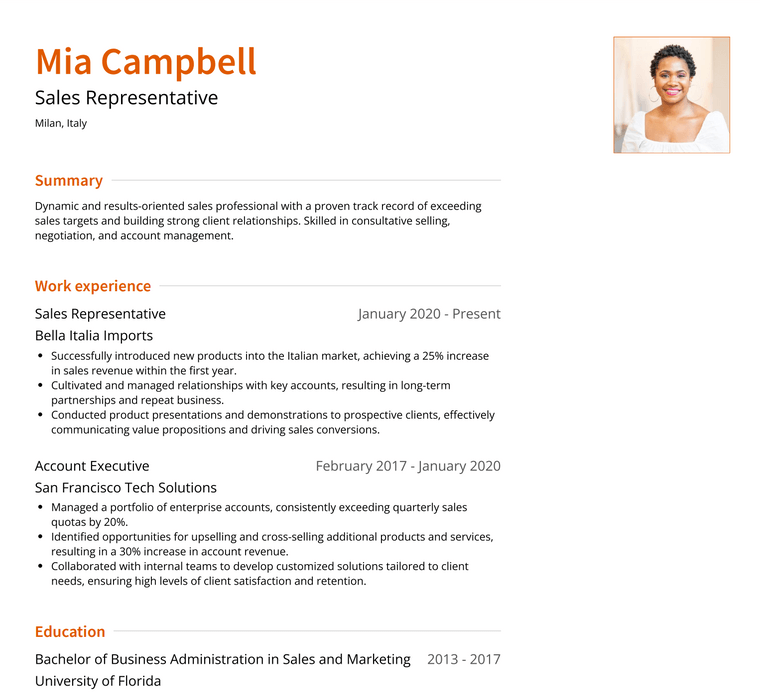
Writer Resume Example for Italy
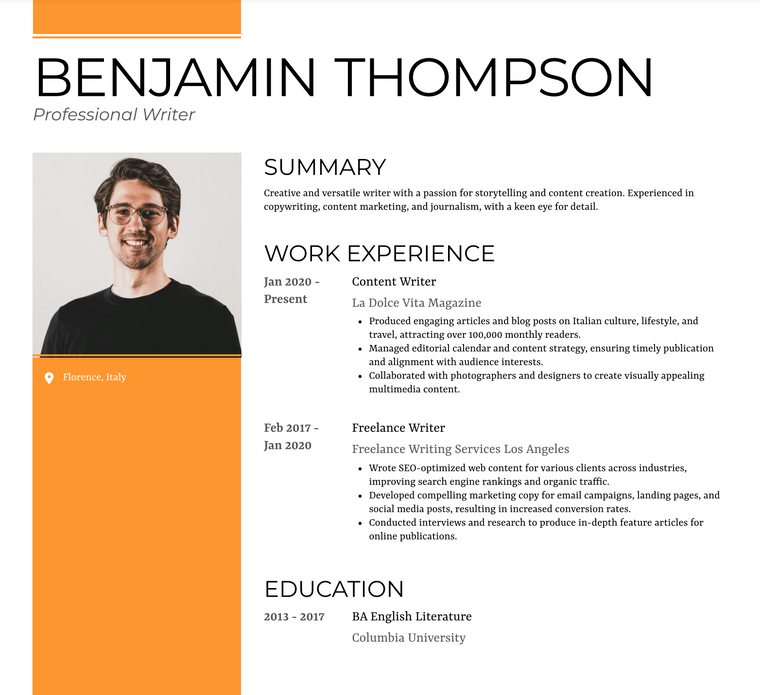
Italian Resume Example for Accountants
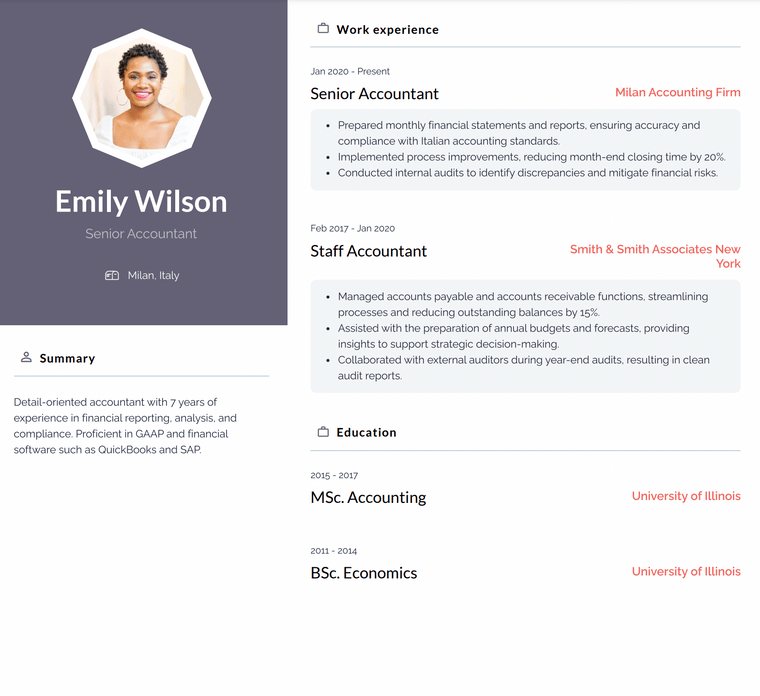
Italian Resume Example for Executives
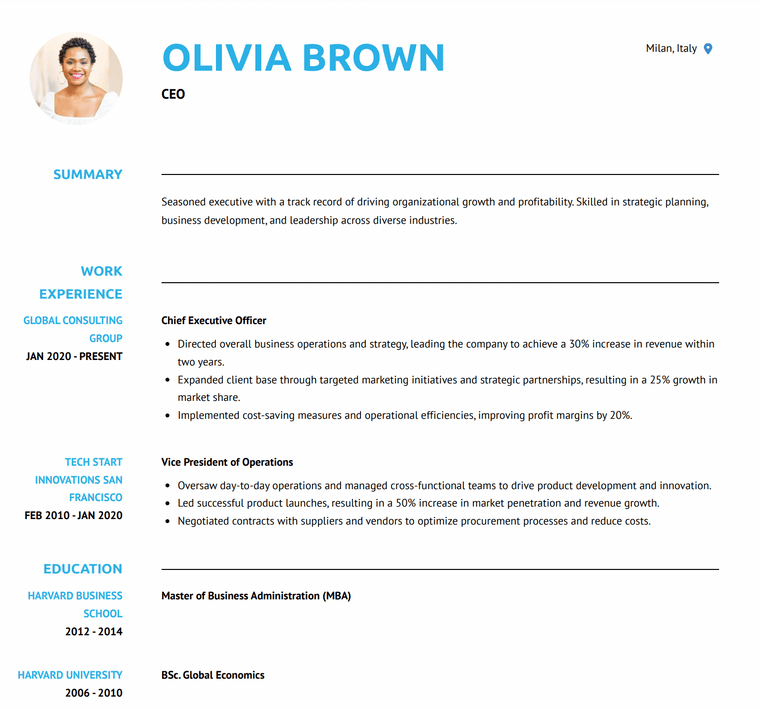
Italian Software Engineering Resume Example

Italian Designer Resume Example
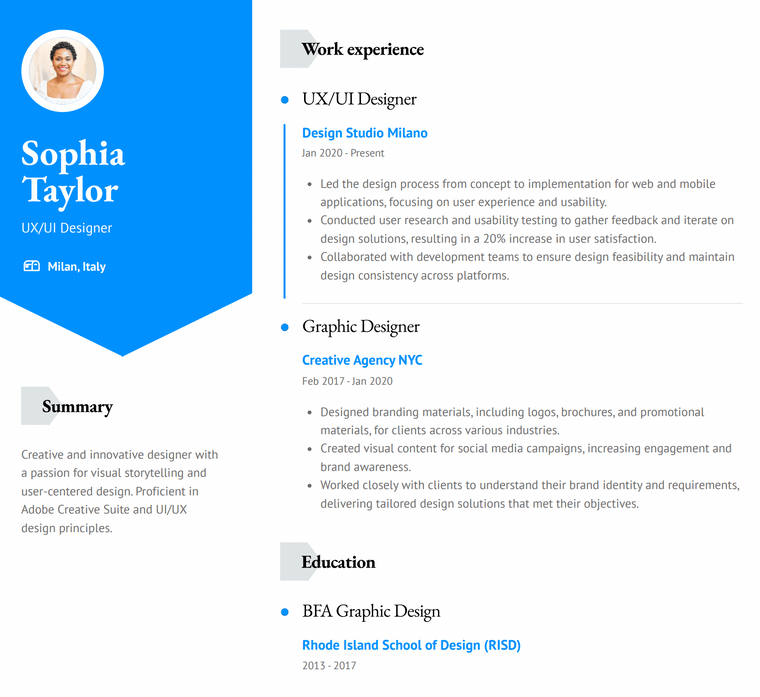
Project Management Resume for Italy
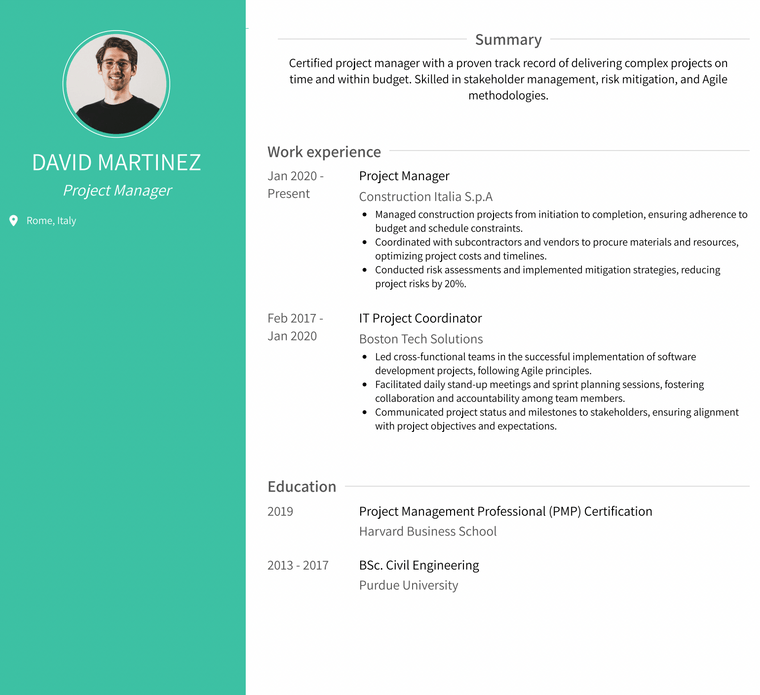
Retail Italian Resume Example
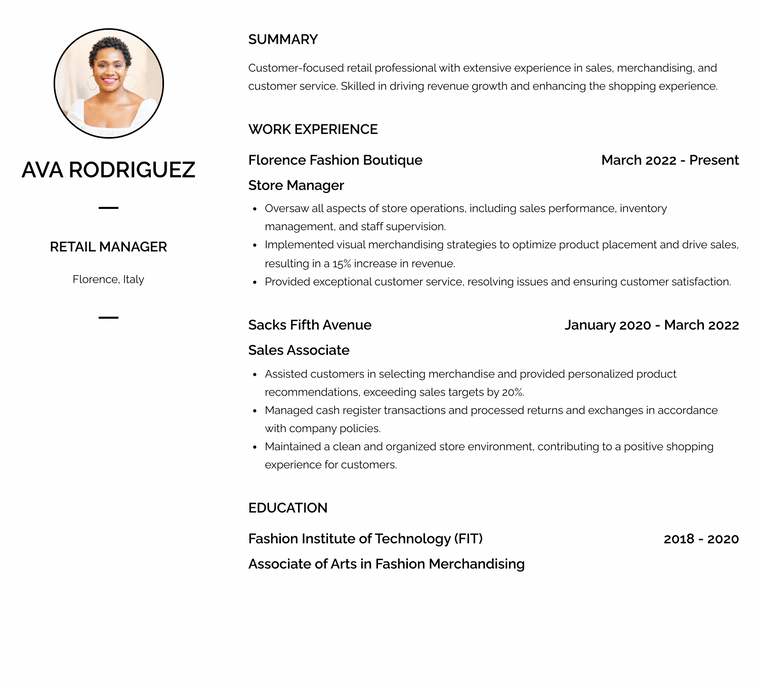
Italian Resume Example for Teachers
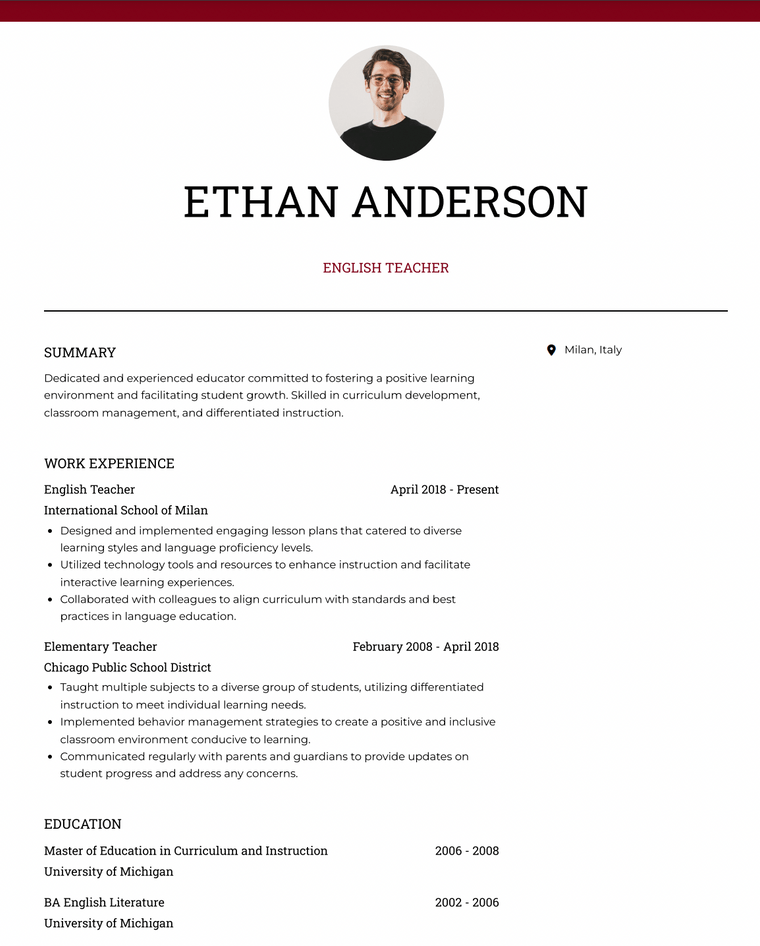
Is an Italian Resume Format Different from An American Resume Format?
An Italian resume format shouldn’t differ too much from an American resume format. Generally speaking, you can easily use an American style resume when applying for jobs in Italy. However, Italian resumes are expected to contain more personal information than is common for American resumes. You should include your date and place of birth, nationality, marital status, and whether or not you have a driver’s license and/or have served in the military.
How Long Should my Italian Resume be?
Italian resumes should be brief and relatively formal. The length of your Italian resume should not exceed 2 pages.
Should I Add a Photo to my Italian Resume?
Yes, it’s common practice to add a photo to an Italian resume. This isn’t a strict or legal requirement, but a resume without a photo may look out of place or unprofessional.
Is it a Good Idea to List Marital Status on a Resume for Italy?
Yes, you should include your marital status in your Italian resume.
Should I List My Nationality on a Italian Resume?
Yes, you should list your nationality on your Italian resume.
Can I Lie on My Italian Resume?
You should never lie on a resume, regardless of the country in which you’re applying! Lying on your resume only ever leads to further stress and disappointment down the road. If you’re having trouble getting started on your Italian resume, a resume writing service would be much more helpful than lying.
Copyright ©2025 Workstory Inc.